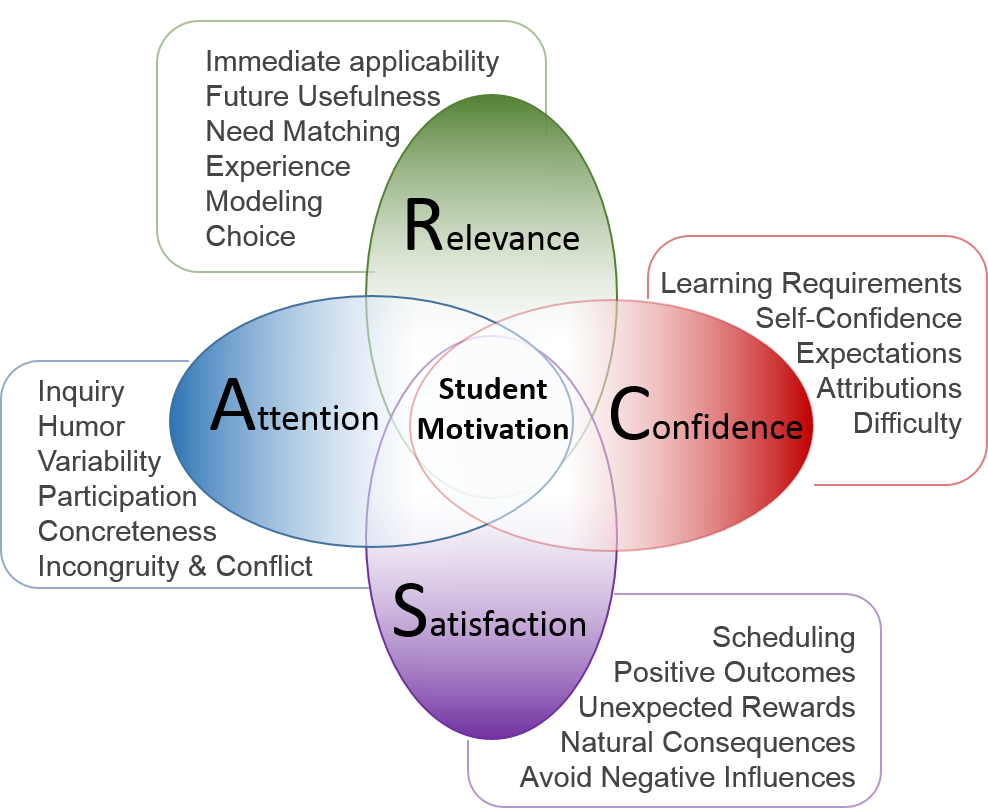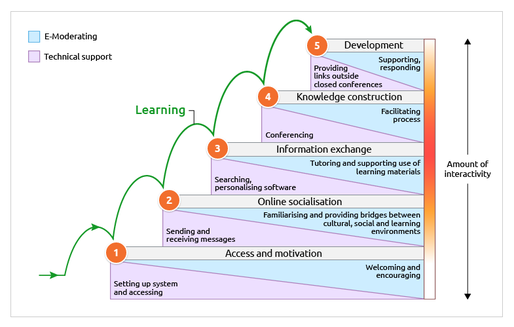Let’s look at some popular strategies for motivating online learners. In this article, I will look at the temporal strategies, 5-Stage Gilly Salmon’s Model, Wolodkowski’s time continuum model and Keller’s ARCS model for motivating learners.
Temporal Strategies
This is basically about applying different strategies, techniques and providing different levels of support and stimulation at the different stages of the learning process.
- Precourse strategy planning.
- Introductory week.
- First proofing of technology
- Prioritise motivation strategies
- Design a motivation strategy that changes as the module is delivered.
5 Stage Model – Gilly Salmon
The five-stage model provides a framework – helps to structure the programme activities. Each stage has a different level of support involved. It is also clear from the 5 Stage model that the successful e-learning, requires the scaffold consisting of appropriate proportions of e-moderation add technical support.
Time Continuum Model (Wolodkowski)
Wlodkowski’s identified three critical periods in the learning process: the before and beginning of the learning process/instruction ( focuses on the attitudes and needs of the learners), during the learning process/instruction (focus on increasing the learner stimulation) and at the end of the learning process (focus on competence and reinforcement). During these staged the motivation is most important. Wolodkowski argues that there are three main factors in instruction: Value of the learning materials, The degree of stimulation provided by the learning, Perseverance-How well do the students sustain their interest in the learning material (resource)
ARCS model (Keller)
ARCS is an Instructional Design model that focuses on motivation. It was developed by J Keller and is one of the most commonly used motivational design models. ARCS is an acronym for Attention, Relevance Confidence and Satisfaction. The examples of the components and method used to stimulate them to achieve increased motivation can be found in this blog post from Learning Industry

What other factors have an influence?
Awareness of Technology
Technology impacts students engagement, motivation, persistence and participation. It is important to be aware that while positively contributing to many aspects of learning (flexibility of time, place, collaborative learning etc) it can also have a negative impact on the learning process. It is important that the use of technologies is well planned. Technology integration must have a purpose for it to be beneficial and produce positive results. Awareness of technological issues also means ensuring the accessibility understood not only as removing barriers for students with disabilities but in a much broader context where online resources can be accessed regardless of technology or environment (Seale, 2013). Testing the platform and methods that are planned to be used both from the tutor and end-user perspective is necessary. The tutor, facilitator and designer role is to remove barriers to participation and engagement in online experiences.
- Can tasks be submitted on time?
- Be aware of demotivation due to poor internet access.
- Do the webinars make sense if interrupted by tech fault.
- Assessing participation if the group is big and time is short.
- Side chats may be distractive.
Student Engagement
Encourage Self-Directed Learning
- Make sure students are ready to learn – assess their readiness to learn. Assess learning gaps to make any adjustments.
- Communication of learning goals between a student and the tutor is necessary. Learning contracts are highly recommended tools for successful self-directed learning. (Learning contract lists the learning goals and outlined planned activities to achieve these goals. It should include the timeline for completion of these activities and plan for tracking progress).
- Create manageable learner-centred goal – help students with their goal’s roadmap. Setting small, easily achievable goals at the beginning helps students to understand the process of setting and achieving a goal. Following that they will be more ready to for more complex goals.
- Use confidence-boosting techniques tactics, communication (e.g. by discussing their strengths or abilities, creating manageable goals)
- Encourage students to understand themselves as learners in order to understand their needs as self-directed learning. If helps if students understand their approach to study (e.g. deep approach, surface approach, strategic approach
- Give them control over certain aspects of the programme. Possibility to control and choose modules, eLearning activities, assignment topics, platforms or tools that cater to individual learning behaviours and personal preferences can be empowering, more relevant and motivating.
- Incorporate additional resources
Communication
- Introducing Live Element – some sorts of live interaction – e.g. chats, webinars, work in groups where students have to liaise with their peers increases the sense of belonging overcome feeling of isolation
- Personalisation is about addressing various factors that impact students’ ability to learn eg. skills, competencies, learning styles, age, demographics, cultural background, the level of education is important. In communication, this would be for example getting to know your students and personalising the conversation (this might be difficult if there are hundreds or thousands, but the automation can help with personalising learners by capturing names as part of the registration process). Using photos or videos can also make contact more personal.
- Reflective questions to stimulate and challenge learners
- Cultivate the friendly and positive classroom environment. This should be a place where students are free to speak their minds.
- Monitor, Analyse and React (Analytics is not the same thing as assessment. The analysis of student engagement in learning could be used to contribute to influencing students success, motivation etc.
Course design and structure
- Graphic Design, Instructional Design, Motivational Design – ensuring the best practices are follows. Design factors could improve or discourage students from getting engaged (e.g is it user-friendly, is it accessible, logically structured etc. )
- Applying both usability design and motivational design together for the best results.
Course usefulness and relevance
- Usefulness
- Relevance
Developing an Online Community
- Feedback and Reward
- Enhance Motivation
- Nurture through feedback
- Show different stages in the growth




JOIN MY NETWORK, STAY CONNECTED, GET IN TOUCH!
JOIN MY NETWORK!
RELATED POSTS
8 types of learning infographics to create engaging learning experiences
15 learning design mistakes you should avoid when creating online courses